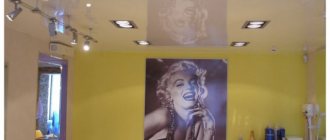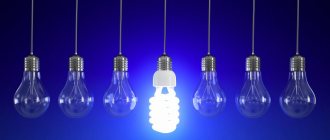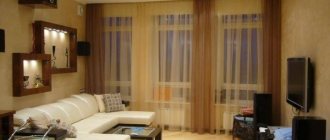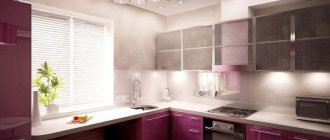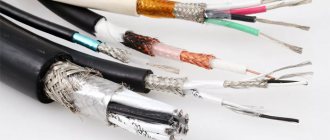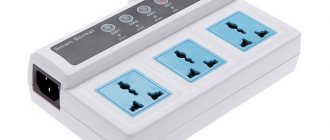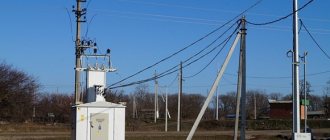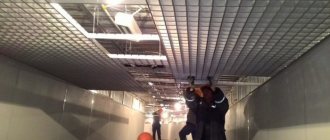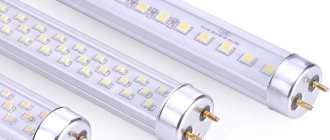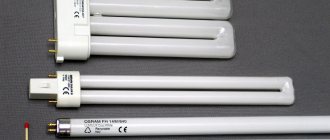To plan lighting in rooms with suspended ceilings, Armstrong often uses built-in or overhead ceiling lights with fluorescent lamps. Armstrong fluorescent ceiling lights are ideally integrated into a suspended ceiling system - any of its individual slabs can be replaced by a light source.
This allows you to achieve optimal distribution of lamps in space, making the lighting uniform or, conversely, dividing it into zones with different intensities.
How long have people been using fluorescent lamps?
The production of fluorescent lamps began in the late 1930s. Outwardly, they have hardly changed. And then this light source was a tubular lamp filled with argon and mercury vapor. Halophosphate phosphors converted ultraviolet radiation into light familiar to the human eye.
From the very beginning, people noticed that the lighting from these lamps resembled natural light on a cloudy day. It was then that they began to be called “fluorescent lamps.”
Today, fluorescent lamps are used everywhere, especially in public spaces. If you look closely, for the Armstrong ceiling they use lamps with precisely such fluorescent lamps.
Types of LED lamps
There are different types of lighting installations.
The first type - plug-in - is based on installation into a frame part. To do this, a distance of twenty centimeters must be maintained between the main ceiling and suspended structures. The design is the most varied. This can be a flat surface of a classic design or spherical models with a recess in the body. They can be used for various ceilings:
- Armstrong - typical;
- Instrument panels in a cassette ceiling, which are assembled in the same way;
- Grilyato lighting devices are made of metal. They are inserted into cells made specifically for this purpose. They differ in appearance and size.
Distinctive features of the Armstrong overhead LED lamp are its dimensions of six hundred millimeters by six hundred. In addition, their end sides are made very aesthetically. They can simply be fixed to the surface of the slab or to concrete, plasterboard and other types of surfaces.
This provides the most important advantage in which it is not necessary to mount the frame part, as well as the suspended structure. The device can easily be mounted on walls or a vertical surface.
There are combined models that are very convenient for choosing installation - Armstrong and Grilyato ceiling systems. In terms of price, they do not differ significantly. Such innovative devices are quite in demand.
The difference between Armstrong pendant lighting fixtures is that they have suspensions, thanks to which they are mounted on the ceiling. The device can be mounted by hanging or overhead with adjustment of the required length of the suspension.
Any type of lamp can have a diffuser. It allows you to open or close the light source. Such a plate is usually made of transparent material. It is located at the bottom of the structure. The aesthetic appearance of closed models is a plus in their favor. They perfectly soften the emitted light fluxes.
Advantages of fluorescent lamps compared to incandescent lamps
If we compare a conventional incandescent lamp and a fluorescent lamp from Armstrong suspended ceiling lamps First of all, this is the high light output of fluorescent lamps. In terms of brightness, 20 W in such a lamp gives the same illumination as 100 W in an incandescent lamp. This comparison clearly demonstrates their high efficiency.
Fluorescent lamps provide a variety of shades of light. It can be cool or warm, with high or low color rendering and light output, white or bluish. By choosing the right fluorescent lamp, you can create comfortable lighting for your home, office, garage, and even museum exhibition hall.
And, of course, such lamps have a significantly longer service life than the usual Ilyich light bulbs. A fluorescent lamp can work up to 20,000 hours, while the life of an incandescent lamp rarely exceeds 1,000 - 2,000 hours. True, the fluorescent lamp needs to be provided with the correct operating mode: it does not tolerate constant switching on and off of the lighting. Therefore, fluorescent lamps are in demand in public spaces, where the lights remain on for 10-12 hours a day, or even longer.
It must be admitted, however, that today fluorescent lamps are beginning to give up their positions to modern LED light sources, which are also installed in the Armstrong ceiling luminaire. However, you can read about this in a separate article.
How to read fluorescent lamp labels?
The diameter of the lamp tube on the marking is indicated by the letter T with a digital code corresponding to the diameter expressed in eighths of an inch. The T8 marking, corresponding to a lamp diameter of 26 mm, is widely used. Accordingly, T5 will indicate a diameter of 16 mm, and the code T4 means that the diameter of the lamp is only 12 mm. The letter G with a digital code indicates the correspondence of the lamp to a specific base. For example, G13.
Another important code is the three-digit one. It shows the type of phosphor. Lamps with a code of 840 are perfect for lighting office spaces, while a light source with a code of 530 is suitable only for a garage, utility room or kitchen, since it produces light in warm tones with poor color rendering and light output. Objects around you will appear low-contrast and brownish.
Fluorescent lamp device
Although fluorescent lamps are ubiquitous today, their design remains quite complex. Such a lamp will not work directly from the electrical network, as incandescent lamps do. In order to start the process of transformation of ultraviolet radiation, which occurs in the gaseous environment of a fluorescent lamp, certain conditions are needed. They can be created using a special device - ballast. It is also called ballast. Today, fluorescent lamps used in Armstrong luminaires use connection circuits with electromagnetic (abbreviated as EMBA) or electronic ballast (abbreviated as EPGB). The latest version of the ballast is more modern and allows you to reduce the electrical energy consumption of a fluorescent lamp by 20-25 percent compared to lamps operating in conjunction with electric ballasts.
Buy LED ceiling lamps "Armstrong" in Moscow
The online store “Innovative Technologies” offers to sell Armstrong-type LED ceiling lamps wholesale and retail. Placing an order is simple: the desired product is added to the cart and paid using the appropriate method:
- payment card;
- bank transfer;
- cashless payments.
Buy Armstrong LED ceiling lights with delivery by courier or transport service. If defects are detected, the product will be accepted within a week for exchange or refund of the price paid.
Contact Innovative Technologies - the client purchases certified products at cheap prices. The company works with individuals and individuals and helps select administrative lighting for each need.
Applications are accepted through the website or by contact phone in Moscow.
Types of reflectors and diffusers of Armstrong fluorescent lamps
If you use a fluorescent lamp without a reflector , its useful light is reduced. Therefore, an important part of the lighting box of an Armstrong lamp is the reflector.
A common office option is a fluorescent lamp with an open mirror reflective grille. It provides the bright lighting needed for a comfortable work environment.
The material for the manufacture of most diffusers today is a high-quality glass substitute - polystyrene. It can be monolithic or embossed. Embossing “prism” and “crushed ice” has a very high light transmittance - 90%.
A version of a closed lamp with a plastic diffuser is suitable for children's institutions, hospitals, and health centers. The matte opal diffuser has a light transmittance of 65%. It creates a soft light that is easy on the eyes.
A diffuser made from painted perforated metal is another way to create soft, unobtrusive lighting. Perforated metal not only diffuses light, but also reliably protects the lamps from accidental damage.
Methods for installing Armstrong lamps
There are two options:
- With external fastening;
- With built-in type mount.
The second type is completely “taken into itself” by the suspended structure. The body part and parts become invisible. The mirror detail remains visible.
An outdoor type installation involves going slightly beyond the boundaries, but with maximum light output.
It is possible to arrange lighting fixtures using their full discretion. They can go side by side, like chess squares, in a diagonal version. They can be concentrated in one place, illuminating a specific work space.

